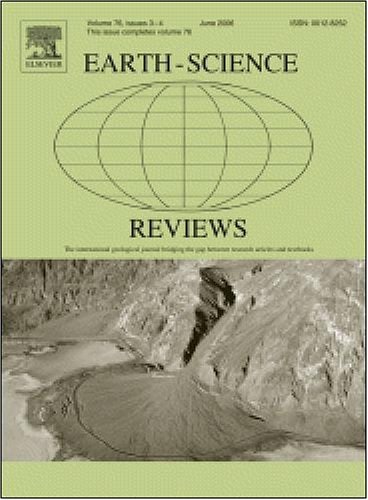IF 10.8
1区 地球科学
Q1 GEOSCIENCES, MULTIDISCIPLINARY
引用次数: 0
摘要
朝鲜半岛是东亚的重要组成部分,因此了解其构造发展对理解整个东亚的地壳演化具有重要影响。然而,关于朝鲜半岛是在二叠纪-三叠纪中韩(华北)克拉通(SKC)和华南克拉通(SCC)碰撞过程中形成的,目前仍存在争议。关于朝鲜半岛不同部分的构造亲缘关系,人们提出了各种假说,这使得正确理解东亚构造演化变得更加复杂。这部分是由于在对朝鲜半岛构造的理解中,最初在 "地质旋回 "时代提出的一个业已存在的地质框架发挥了关键作用。这一框架将基底岩石分为南林、京畿和岭南三块 "地块"。我们不受这一已有范式的束缚,在此根据古生物学、沉积学、岩石学和地质年代学等多学科地质数据,对朝鲜半岛的构造演化提供了一个新的视角。通过对这些数据的综合重新解释,我们认识到了朝鲜半岛发展的关键见解:(1) 京畿道两个 "区块 "的古近纪结晶岩是韩国大陆架南缘的基底岩,在二叠三叠世碰撞过程中被韩国大陆架东端地壳俯冲拖拽下来,然后在晚三叠世伸展过程中被挤出;(2) 在晚三叠世和白垩世伸展机制期间,在构造边界附近发育了各种规模的大陆核复合体,从而在整个朝鲜半岛形成了共生的小型非海相盆地;(3) 南韩中西部的国泰岩块-亲缘岩是由晚三叠世洪城核复合体带到地表的;以及 (4) 围绕朝鲜半岛西海岸的黄海-泰安带是由晚白垩世的 "大陆地壳扩张 "事件形成的。因此,我们提出了朝鲜半岛构造省的新划分,这与之前提出的构造模型并不一致,之前提出的构造模型要么是贯穿半岛的简单碰撞带,要么是整个半岛都属于SKC。我们提出了代表晚白垩世至二叠纪地质组成部分的朝鲜半岛逆行重建,并将结果与二叠三叠世 SKC 和 SCC 碰撞框架相结合。在新的视角下,可以重新审视朝鲜半岛已知的地质方面和事件。除东北部地块--马草岭地块、关墨地块和杜芒岗地带外,朝鲜半岛的构造带自西北向东南依次为南林地壳展布带(包括平南地区)、黄海地区、临津江地带、京畿西部地块、京畿中部地块、玉泉地带(包括太白山群)和岭南地块。临津江带和玉川变质岩带中与南大陆架有亲缘关系的变质岩是南大陆架北缘泥盆纪-石炭纪被动边缘沉积物及其底质形成的前泥盆纪岩石,这些岩石在大陆碰撞过程中发生俯冲,并在晚三叠世被掘出。在古生代晚期,随着南大陆架向北大西洋靠近,形成了大陆弧系统,而古生代晚期的平安超群则形成于大陆碰撞之前北大西洋南缘发育的弧前盆地。SKC和SCC的上地壳边界横跨 "太白山复合体",其标志是源自SCC的宁月组与源自SKC的太白组和平安超群之间的边界。最重要的是,朝鲜半岛三大著名造山带被重新定义。松林造山带包括与二叠三叠世 SKC 和 SCC 碰撞有关的事件,并细分为早期、中期和晚期。早、中期分别代表了增生楔引起的变质作用和主要的大陆碰撞事件,而晚期则代表了碰撞后的掘起事件和核心复合体的发展。侏罗纪大保造山运动是由古太平洋(伊赞那木)板块的平面俯冲造成的,它形成了遍布半岛的侏罗纪花岗岩、玉泉带的推力-断层系统以及韧性的湖南剪切带。白垩纪佛国寺造山运动代表了古太平洋(伊邪那岐)板块后退造成的伸展机制,该造山运动从西北向东南逐步发展出岩心复合体,并很可能在造山运动的早期阶段引发了一次扩张造山运动。本文章由计算机程序翻译,如有差异,请以英文原文为准。

Tectonic evolution of the Korean Peninsula: A new paradigm for critical building blocks of East Asia
The Korean Peninsula occupies a critical part of East Asia, and thus understanding its tectonic development has a significant impact on comprehending the crustal evolution of the entire East Asia. However, there is still contention surrounding the formation of the Korean Peninsula during the Permian-Triassic collision of the Sino-Korean (North China) Craton (SKC) and the South China Craton (SCC). Various hypotheses have been proposed regarding the tectonic affinity of different parts of the Korean Peninsula, complicating the proper understanding of the tectonic evolution in East Asia. This is partly due to a pre-existing geological framework that has played a pivotal role in the tectonic understanding of the Korean Peninsula, originally suggested during the age of the ‘geosyncline.’ This framework involves the tripartite division of the basement rocks into the Nangrim, Gyeonggi, and Yeongnam “massifs.” Not bound by this pre-existing paradigm, here we provide a new perspective on the tectonic evolution of the Korean Peninsula based on multidisciplinary geological data, including paleontology, sedimentology, petrology, and geochronology. An integrative reinterpretation of the data has led to the recognition of critical insights on the development of the Korean Peninsula: (1) the Paleoproterozoic crystalline rocks of the two Gyeonggi ‘blocks’ were basement rocks of the SKC southern margin that were dragged down by the subduction of the eastern tip of the SCC crust during the Permo-Triassic collision and then exhumed during the Late Triassic extensional regime; (2) continental core complexes of various sizes developed near the tectonic boundaries during the Late Triassic and Cretaceous extensional regimes, resulting in the formation of coeval small non-marine basins throughout the Korean Peninsula; (3) the Cathaysia Block-affinity rocks in the midwestern part of South Korea were brought up to the surface by the Late Triassic Hongseong Core Complex, and; (4) the Hwanghae-Taean Belt around the western coast of the Korean Peninsula was formed by a Late Cretaceous ‘continental crust spreading’ event. Accordingly, a new subdivision of tectonic provinces of the Korean Peninsula is presented, which does not accord with the previous tectonic models that proposed either a simple collision belt running through the peninsula or the entire peninsula belonging to the SKC. We present retrograde reconstructions of the Korean Peninsula, representing the geological components from the Late Cretaceous to Permian, and integrate the results with the framework of the Permo-Triassic collision between the SKC and the SCC. Under the new perspective, geological aspects and events known in the Korean Peninsula can be revisited. Except for the northeastern terranes, the Macheollyeong Block, the Gwanmo Massif, and the Dumangang Belt, the tectonic provinces of the Korean Peninsula, from northwest to southeast, consist of the Nangrim Spread Crustal Region (SCR) (including the Pyeongnam District), Hwanghae District, Imjingang Belt, Western Gyeonggi Block, Central Gyeonggi Block, Okcheon Belt (including the Taebaeksan Complex), and Yeongnam Block. The metasedimentary rocks with the SCC-affinity in the Imjingang Belt and the Okcheon Metamorphic Belt were the Devonian-Carboniferous passive margin sediments and their substratum-forming pre-Devonian rocks in the northern margin of the SCC, which were subducted during the continental collision and exhumed in the Late Triassic. A continental arc system was formed as the SCC approached the SKC in the late Paleozoic, and the late Paleozoic Pyeongan Supergroup was formed in forearc basins developed at the southern margin of the SKC before the continental collision. The supracrustal boundary of the SKC and the SCC runs across the ‘Taebaeksan Complex,’ which is marked by the boundary between the SCC-derived Yeongwol Group and the SKC-derived Taebaek Group and Pyeongan Supergroup. Most importantly, the three renowned orogenies in the Korean Peninsula are redefined. The Songrim Orogeny encompasses the events related to the Permo-Triassic collision between the SKC and the SCC and is subdivided into the Early, Middle, and Late phases. The Early and Middle phases represent the accretionary wedge-induced metamorphism and the main continental collision events, respectively, while the Late Phase is represented by post-collisional exhumation events and core complex developments. The Jurassic Daebo Orogeny was caused by the flat subduction of the Paleo-Pacific (Izanagi) Plate that formed the widespread Jurassic granitoids across the peninsula, the thrust-fault systems in the Okcheon Belt, and the ductile Honam Shear Zone. The Cretaceous Bulguksa Orogeny represents the extensional regime caused by the rollback of the Paleo-Pacific (Izanagi) Plate, which progressively developed core complexes from northwest to southeast and likely triggered an epeirogeny in the early phase of the orogeny. The new tectonic perspective of the Korean Peninsula will provide a critical new basis for the tectonic understanding of the Korean Peninsula, as well as a new insight into the tectonics of East Asia.
求助全文
通过发布文献求助,成功后即可免费获取论文全文。
去求助
来源期刊

Earth-Science Reviews
地学-地球科学综合
CiteScore
21.70
自引率
5.80%
发文量
294
审稿时长
15.1 weeks
期刊介绍:
Covering a much wider field than the usual specialist journals, Earth Science Reviews publishes review articles dealing with all aspects of Earth Sciences, and is an important vehicle for allowing readers to see their particular interest related to the Earth Sciences as a whole.
 求助内容:
求助内容: 应助结果提醒方式:
应助结果提醒方式:


